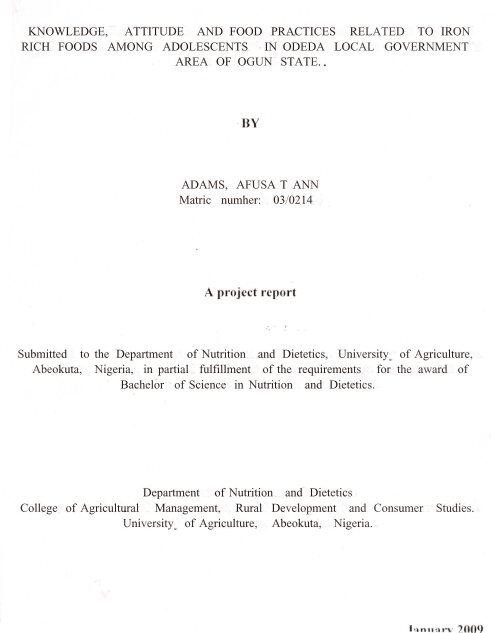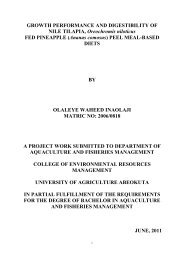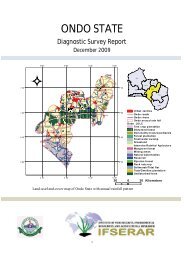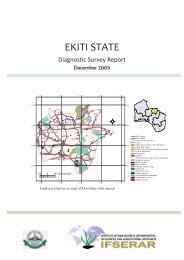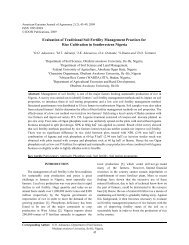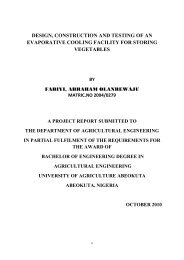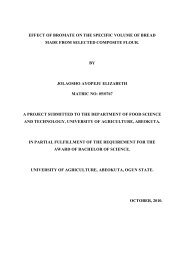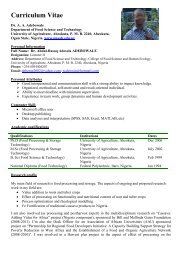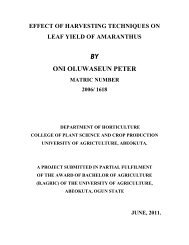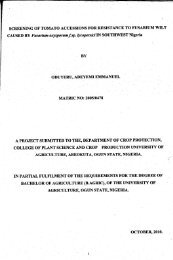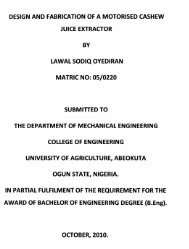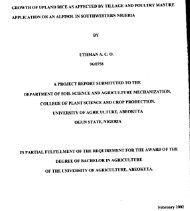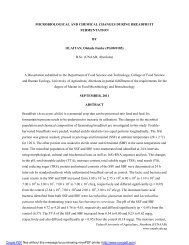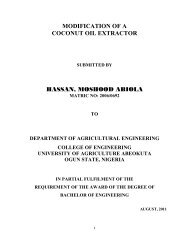knowledge, attitude and food practices related to iron rich foods ...
knowledge, attitude and food practices related to iron rich foods ...
knowledge, attitude and food practices related to iron rich foods ...
Create successful ePaper yourself
Turn your PDF publications into a flip-book with our unique Google optimized e-Paper software.
KNOWLEDGE, ATTITUDE AND FOOD PRACTICES RELATED TO IRON<br />
RICH FOODS AMONG ADOLESCENTS IN ODEDA LOCAL GOVERNMENT<br />
AREA OF OGUN STATE.<br />
ADAMS, AFUSA T ANN<br />
Matric numher: 03/0214<br />
Submitted <strong>to</strong> the Department of Nutrition <strong>and</strong> Dietetics, University of Agriculture,<br />
Abeokuta, Nigeria, in partial fulfillment of the requirements for the award of<br />
Bachelor of Science in Nutrition <strong>and</strong> Dietetics.<br />
Department of Nutrition <strong>and</strong> Dietetics<br />
College of Agricultural Management, Rural Development <strong>and</strong> Consumer Studies.<br />
University of Agriculture, Abeokuta, Nigeria.
The <strong>knowledge</strong>, <strong>attitude</strong> <strong>and</strong> <strong>food</strong> <strong>practices</strong> <strong>related</strong> <strong>to</strong> Iron <strong>rich</strong> <strong>food</strong>s among<br />
adolescents was assessed. Five public schools were used out of ten public schools in<br />
Oded a Local Government Area, Ogun State, Nigeria, was used for the study.<br />
A <strong>to</strong>tal of one hundred <strong>and</strong> forty one adolescents v,ere made the respondents for the<br />
study in which one hundred <strong>and</strong> twenty were analyzable. Well structured <strong>and</strong> validated<br />
questionnaires<br />
were used in data collection.<br />
Data was analyzed using descriptive statistics <strong>to</strong>ols such as statistical package~ for<br />
social sciences (SPSS) <strong>to</strong> analyze in frequency counts, percentages, mean <strong>and</strong> bar chart.<br />
Data obtained indicated that 52.5% of the sampled respondents knew that <strong>iron</strong> is a trace<br />
mineral. 69.17% of them do not know what <strong>iron</strong> implies. Many of the respondents<br />
56.67% believed that <strong>rich</strong> sources of <strong>iron</strong> come from plant <strong>food</strong>s. And the average<br />
mean of the pre-pubertal <strong>and</strong> pubertal adolescent were 16.80 mg <strong>and</strong> 16.57mg<br />
respectively.<br />
Data obtained also indicated that the <strong>food</strong> <strong>practices</strong> of the adolescents may continue <strong>to</strong><br />
adulthood because the highest percent 80.83% feeJ on rice more than once daily <strong>and</strong><br />
68.33% on garri more than once daily. Also highest percentage of snacks was<br />
consumed than once daily <strong>and</strong> everyday intake. And they feed moderately on '·ruits <strong>and</strong><br />
vegetables while considerable percent of meat. poultry <strong>and</strong> dairy was consumed.<br />
This study has revealed the need for nutritional intervention <strong>to</strong> educate <strong>and</strong> orientate<br />
adolescents on the sources <strong>and</strong> functions of <strong>iron</strong> <strong>rich</strong> <strong>food</strong>s <strong>and</strong> the importance of<br />
supplementation <strong>to</strong> prevent anemia in the future.


